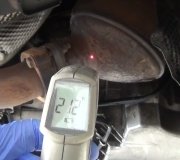Hi,
Is the check engine light staying on when the engine is running? I ask because if it is, we need to retrieve the diagnostic trouble codes stored in the system. Most parts stores will do it for free. That would point us in the right directions.
Otherwise, we need to start checking one component at a time. A rough idle, loss of power, and stalling can be several things. What you indicated could be the issue, fuel pressure. What I can do is this. I will provide links specific to checking for fuel pressure, power loss (which can be related to a partially plugged catalytic converter), and stalling.
Take a look through these and let me know if they help. I will also include a quick video showing how to use a scanner.
__________________________________
https://www.2carpros.com/articles/stall-at-idle
https://www.2carpros.com/articles/bad-catalytic-converter-symptoms
https://www.2carpros.com/articles/how-to-test-a-catalytic-converter
https://www.2carpros.com/articles/how-to-check-fuel-system-pressure-and-regulator
https://youtu.be/YV3TRZwer8k
_________________________________
Here are the directions and specifications for testing fuel pressure specific to your vehicle. The attached pics correlate with the directions.
________________________________
1996 Nissan-Datsun Maxima V6-2968cc 3.0L DOHC MFI (VQ30DE)
Fuel Pressure Test
Vehicle Powertrain Management Fuel Delivery and Air Induction Fuel Pump Fuel Pressure Testing and Inspection Component Tests and General Diagnostics Fuel Pressure Test
FUEL PRESSURE TEST
NOTE:
- When reconnecting fuel line, always use new clamps.
- Make sure that clamp screw does not contact adjacent parts.
- Use a torque driver to tighten clamps.
- Use Pressure Gauge to check fuel pressure.
PROCEDURE
1. Release fuel pressure to zero.
2. Disconnect fuel hose between fuel filter and fuel tube (engine side).
pic 1
3. Install pressure gauge between fuel filter and fuel tube.
4. Start engine and check for fuel leakage.
5. Read the indication of fuel pressure gauge.
At idling:
Approximately 235 kPa (2.4 kg/cm2, 34 psi)
A few seconds after ignition switch is turned OFF to
ON:
Approximately 294 kPa (3.0 kg/cm2, 43 psi)
6. Stop engine and disconnect fuel pressure regulator vacuum hose from intake manifold.
7. Plug intake manifold with a rubber cap.
8. Connect variable vacuum source to fuel pressure regulator.
Vacuum/fuel Pressure Test
pic 2
9. Start engine and read indication of fuel pressure gauge as vacuum is changed.
Fuel pressure should decrease as vacuum increases. If results are unsatisfactory, replace fuel pressure regulator.
______________________________
Let me know what you find or if you have other questions.
Take care,
Joe
Images (Click to make bigger)
Saturday, February 1st, 2020 AT 9:07 PM





